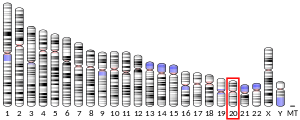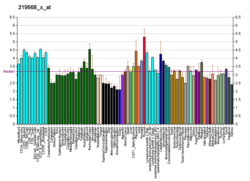SOX18
Transcription factor SOX-18 is a protein that in humans is encoded by the SOX18 gene.[5][6]
Function
This gene encodes a member of the SOX (SRY-related HMG-box) family of transcription factors involved in the regulation of embryonic development and in the determination of the cell fate. The encoded protein may act as a transcriptional regulator after forming a protein complex with other proteins. This protein plays a role in hair, blood vessel, and lymphatic vessel development. Mutations in this gene have been associated with recessive and dominant forms of hypotrichosis-lymphedema-telangiectasia (HLTS).[7][6] An autosomal truncating dominant mutation in this gene has also been associated with renal failure in the condition hypotrichosis-lymphedema-telangiectasia-renal defect syndrome (HLTRS).[8][9]
Interactions
SOX18 has been shown to interact with MEF2C.[10]
See also
- SOX genes
References
- GRCh38: Ensembl release 89: ENSG00000203883 - Ensembl, May 2017
- GRCm38: Ensembl release 89: ENSMUSG00000046470 - Ensembl, May 2017
- "Human PubMed Reference:". National Center for Biotechnology Information, U.S. National Library of Medicine.
- "Mouse PubMed Reference:". National Center for Biotechnology Information, U.S. National Library of Medicine.
- Azuma T, Seki N, Yoshikawa T, Saito T, Masuho Y, Muramatsu M (July 2000). "cDNA cloning, tissue expression, and chromosome mapping of human homolog of SOX18". Journal of Human Genetics. 45 (3): 192–5. doi:10.1007/s100380050210. PMID 10807548.
- "Entrez Gene: SO X18 SRY (sex determining region Y)-box 18".
- Valenzuela I, Fernández-Alvarez P, Plaja A, Ariceta G, Sabaté-Rotés A, García-Arumí E, Vendrell T, Tizzano E (May 2018). "Further delineation of the SOX18-related Hypotrichosis, Lymphedema, Telangiectasia syndrome (HTLS)". European Journal of Medical Genetics. 61 (5): 269–272. doi:10.1016/j.ejmg.2018.01.001. PMID 29307792.
- Moalem S, Brouillard P, Kuypers D, Legius E, Harvey E, Taylor G, Francois M, Vikkula M, Chitayat D (April 2015). "Hypotrichosis-lymphedema-telangiectasia-renal defect associated with a truncating mutation in the SOX18 gene". Clinical Genetics. 87 (4): 378–82. doi:10.1111/cge.12388. PMID 24697860.
- "Hypotrichosis-Lymphedema-Telangiectasia-Renal Defect Syndrome". The University of Arizona Health Sciences.
- Hosking BM, Wang SC, Chen SL, Penning S, Koopman P, Muscat GE (September 2001). "SOX18 directly interacts with MEF2C in endothelial cells". Biochemical and Biophysical Research Communications. 287 (2): 493–500. doi:10.1006/bbrc.2001.5589. PMID 11554755.
Further reading
- Wilson M, Koopman P (August 2002). "Matching SOX: partner proteins and co-factors of the SOX family of transcriptional regulators". Current Opinion in Genetics & Development. 12 (4): 441–6. doi:10.1016/S0959-437X(02)00323-4. PMID 12100890.
- Schepers GE, Teasdale RD, Koopman P (August 2002). "Twenty pairs of sox: extent, homology, and nomenclature of the mouse and human sox transcription factor gene families". Developmental Cell. 3 (2): 167–70. doi:10.1016/S1534-5807(02)00223-X. PMID 12194848.
- Denny P, Swift S, Brand N, Dabhade N, Barton P, Ashworth A (June 1992). "A conserved family of genes related to the testis determining gene, SRY". Nucleic Acids Research. 20 (11): 2887. doi:10.1093/nar/20.11.2887. PMC 336939. PMID 1614875.
- Dunn TL, Mynett-Johnson L, Wright EM, Hosking BM, Koopman PA, Muscat GE (August 1995). "Sequence and expression of Sox-18 encoding a new HMG-box transcription factor". Gene. 161 (2): 223–5. doi:10.1016/0378-1119(95)00280-J. PMID 7665083.
- Stanojcić S, Stevanović M (June 2000). "The human SOX18 gene: cDNA cloning and high resolution mapping". Biochimica et Biophysica Acta (BBA) - Gene Structure and Expression. 1492 (1): 237–41. doi:10.1016/s0167-4781(00)00078-6. PMID 10858556.
- Pennisi DJ, James KM, Hosking B, Muscat GE, Koopman P (December 2000). "Structure, mapping, and expression of human SOX18". Mammalian Genome. 11 (12): 1147–9. doi:10.1007/s003350010216. PMID 11130989.
- Hosking BM, Wang SC, Chen SL, Penning S, Koopman P, Muscat GE (September 2001). "SOX18 directly interacts with MEF2C in endothelial cells". Biochemical and Biophysical Research Communications. 287 (2): 493–500. doi:10.1006/bbrc.2001.5589. PMID 11554755.
- Dintilhac A, Bernués J (March 2002). "HMGB1 interacts with many apparently unrelated proteins by recognizing short amino acid sequences". The Journal of Biological Chemistry. 277 (9): 7021–8. doi:10.1074/jbc.M108417200. PMID 11748221.
- Saitoh T, Katoh M (September 2002). "Expression of human SOX18 in normal tissues and tumors". International Journal of Molecular Medicine. 10 (3): 339–44. doi:10.3892/ijmm.10.3.339. PMID 12165811.
- Irrthum A, Devriendt K, Chitayat D, Matthijs G, Glade C, Steijlen PM, Fryns JP, Van Steensel MA, Vikkula M (June 2003). "Mutations in the transcription factor gene SOX18 underlie recessive and dominant forms of hypotrichosis-lymphedema-telangiectasia". American Journal of Human Genetics. 72 (6): 1470–8. doi:10.1086/375614. PMC 1180307. PMID 12740761.
- García-Ramírez M, Martínez-González J, Juan-Babot JO, Rodríguez C, Badimon L (November 2005). "Transcription factor SOX18 is expressed in human coronary atherosclerotic lesions and regulates DNA synthesis and vascular cell growth". Arteriosclerosis, Thrombosis, and Vascular Biology. 25 (11): 2398–403. doi:10.1161/01.ATV.0000187464.81959.23. PMID 16179596.
- Young N, Hahn CN, Poh A, Dong C, Wilhelm D, Olsson J, Muscat GE, Parsons P, Gamble JR, Koopman P (August 2006). "Effect of disrupted SOX18 transcription factor function on tumor growth, vascularization, and endothelial development". Journal of the National Cancer Institute. 98 (15): 1060–7. doi:10.1093/jnci/djj299. PMID 16882943.
- Olbromski M, Podhorska-Okołów M, Dzięgiel P. (2018). "Role of the SOX18 protein in neoplastic processes". Oncology Letters. 16 (2): 1383–89. doi:10.3892/ol.2018.8819. PMC 6036441. PMID 30008814.CS1 maint: multiple names: authors list (link)
External links
- SOX18+protein,+human at the US National Library of Medicine Medical Subject Headings (MeSH)
This article incorporates text from the United States National Library of Medicine, which is in the public domain.




